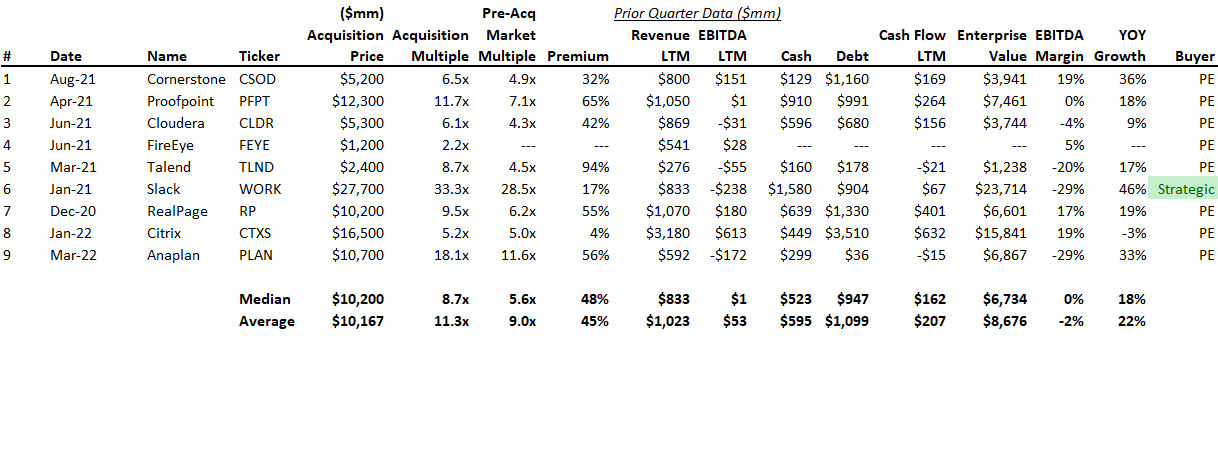摘要: On Monday Thoma Bravo announced the acquisition of Anaplan for $10.7bln.

▲圖片來源:pixabay.com
On Monday Thoma Bravo announced the acquisition of Anaplan for $10.7bln. Below we highlight all the acquisitions of public SaaS companies since December 2020. Alongside multiples of publicly traded SaaS companies, public SaaS acquisitions are some of the most relevant you can look at for deriving SaaS revenue multiples. These transactions are all cash, the financials are public and audited, and these are all control transactions so the data is about as pure as it gets. Observations are below.

Only 9 exits. There have only been 9 public companies acquired since December 2020. Acquisitions of this size don’t happen often. Note that we have incomplete data for one of those companies (FireEye) because as part of the acquisition, a material subsidiary called Mandiant was spun-off ($400mm revenue of $941mm combined revenue), so we do not have all the data for FireEye as a standalone subsidiary.
Capped price. The median acquisition price of these companies was $10.2bln. There’s a lesson here: there are only so many acquirers that can spend billions in cash and/or company stock to make acquisitions. Once you get to $5bln+ in valuation, the universe of corporate acquirers (Salesforce, Microsoft, Adobe) and private equity firms (Thoma Bravo, KKR, Clearlake) that can afford you shrinks, such that IPO becomes the primary viable option. And of course, SaaS IPO’s don’t grow on trees (there were 27 in 2021). There have been no SaaS IPO’s in 2022 as the market is frozen — sellers can’t agree on valuation with institutional buyers that are needed to buoy an IPO. Interal down rounds and flat are coming for all those “unicorns”.
9x revenue. The businesses on median traded for 8.7x trailing twelve month revenue of $833mm with YOY growth of 18%. Note, that means the multiple on the current ARR was inside of 9x since these companies are growing. While that growth may sound low, it’s pretty impressive for companies with nearly $1bln of revenue, so any multiple discount from slower growth should be more than offset by the premium these companies receive for size and the fact that these are control investments. There’s a lesson here as well: it’s fun to raise money from VC at 20x revenue, but recognize that the likelihood of keeping such a high multiple at acquisition is low. It takes a lot of growth to make up for the overpayment and achieving a good venture return for the investor. We always recommend keeping dilution low by taking the money you need at a reasonable valuation as opposed to too much capital at a high valuation. That’s how you avoid down-rounds and restructurings.
Low burn. The EBITDA burn of these companies relative to revenue was pretty negligible with median EBITDA that was break-even (0% margin on median).
Private equity is leading the way. Of the 9 acquisitions shown, only one was made by a strategic (Salesforce). All the rest were made by private equity, with Thoma Bravo actually making 4 of the 9 acquisitions. Again, there are very few firms that can afford a multi-billion dollar acquisition. Not surprisingly, the highest multiple of the group is Salesforce’s, paying 33x revenue for Slack.
轉貼自Source: blossomstreetventures.medium.com
若喜歡本文,請關注我們的臉書 Please Like our Facebook Page: Big Data In Finance


留下你的回應
以訪客張貼回應